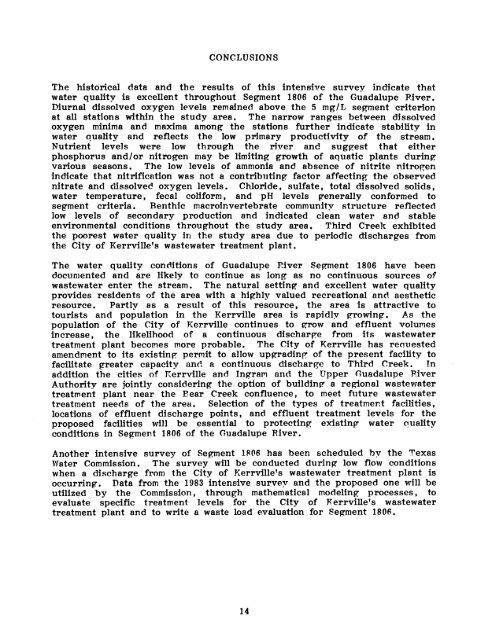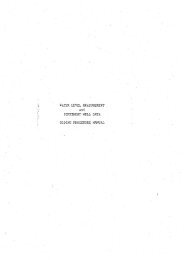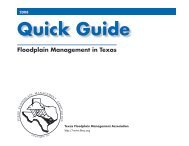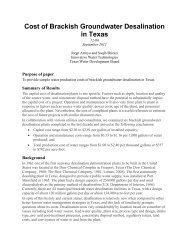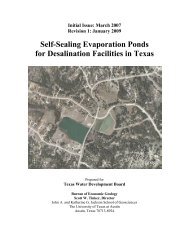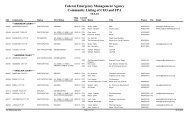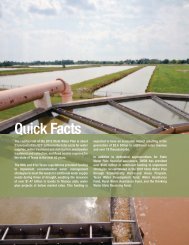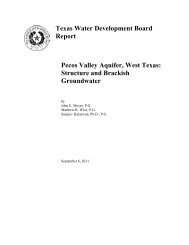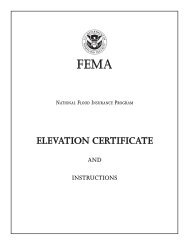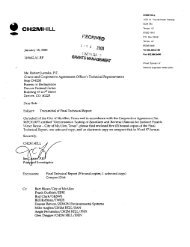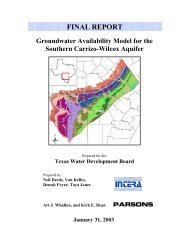Intensive Survey of the Guadalupe River Segment 1806
Intensive Survey of the Guadalupe River Segment 1806
Intensive Survey of the Guadalupe River Segment 1806
Create successful ePaper yourself
Turn your PDF publications into a flip-book with our unique Google optimized e-Paper software.
CONCLUSIONS<br />
The historical data and <strong>the</strong> results <strong>of</strong> this intensive survey indicate that<br />
water quality is excellent throughout <strong>Segment</strong> <strong>1806</strong> <strong>of</strong> <strong>the</strong> <strong>Guadalupe</strong> <strong>River</strong>.<br />
Diurnal dissolved oxygen levels remained above <strong>the</strong> 5 mg/L segment criterion<br />
at all stations within <strong>the</strong> study area. The narrow ranges between dissolved<br />
oxygen minima and maxima among <strong>the</strong> stations fur<strong>the</strong>r indicate stability in<br />
water quality and reflects <strong>the</strong> low primary productivity <strong>of</strong> <strong>the</strong> stream.<br />
Nutrient levels were low through <strong>the</strong> river and suggest that ei<strong>the</strong>r<br />
phosphorus and/or nitrogen may be limiting growth <strong>of</strong> aquatic plants during<br />
various seasons. The low levels <strong>of</strong> ammonia and absence <strong>of</strong> nitrite nitrogen<br />
indicate that nitrification was not a contributing factor affecting <strong>the</strong> observed<br />
nitrate and dissolved oxygen levels. Chloride, sulfate, total dissolved solids,<br />
water temperature, fecal coliform, and pH levels generally conformed to<br />
segment criteria. Benthic macroinvertebrate community structure reflected<br />
low levels <strong>of</strong> secondary production and indicated clean water and stable<br />
environmental conditions throughout <strong>the</strong> study area. Third Creek exhibited<br />
<strong>the</strong> poorest water quality in <strong>the</strong> study area due to periodic discharges from<br />
<strong>the</strong> City <strong>of</strong> Kerrville's wastewater treatment plant.<br />
The water quality conditions <strong>of</strong> <strong>Guadalupe</strong> <strong>River</strong> <strong>Segment</strong> <strong>1806</strong> have been<br />
documented and are likely to continue as long as no continuous sources <strong>of</strong><br />
wastewater enter <strong>the</strong> stream. The natural setting and excellent water quality<br />
provides residents <strong>of</strong> <strong>the</strong> area with a highly valued recreational and aes<strong>the</strong>tic<br />
resource. Partly as a result <strong>of</strong> this resource, <strong>the</strong> area is attractive to<br />
tourists and population in <strong>the</strong> Kerrville area is rapidly growing. As <strong>the</strong><br />
population <strong>of</strong> <strong>the</strong> City <strong>of</strong> Kerrville continues to grow and effluent volumes<br />
increase, <strong>the</strong> likelihood <strong>of</strong> a continuous discharge from its wastewater<br />
treatment plant becomes more probable. The City <strong>of</strong> Kerrville has requested<br />
amendment to its existing permit to allow upgrading <strong>of</strong> <strong>the</strong> present facility to<br />
facilitate greater capacity and a continuous discharge to Third Creek. In<br />
addition <strong>the</strong> cities <strong>of</strong> Kerrville and Ingram and <strong>the</strong> Upper <strong>Guadalupe</strong> <strong>River</strong><br />
Authority are jointty considering <strong>the</strong> option <strong>of</strong> building a regional wastewater<br />
treatment plant near <strong>the</strong> Pear Creek confluence, to meet future wastewater<br />
treatment needs <strong>of</strong> <strong>the</strong> area. Selection <strong>of</strong> <strong>the</strong> types <strong>of</strong> treatment facilities,<br />
locations <strong>of</strong> effluent discharge points, and effluent treatment levels for <strong>the</strong><br />
proposed facilities will be essential to protecting existing water quality<br />
conditions in <strong>Segment</strong> <strong>1806</strong> <strong>of</strong> <strong>the</strong> <strong>Guadalupe</strong> <strong>River</strong>.<br />
Ano<strong>the</strong>r intensive survey <strong>of</strong> <strong>Segment</strong> <strong>1806</strong> has been scheduled by <strong>the</strong> Texas<br />
Water Commission. The survey will be conducted during low flow conditions<br />
when a discharge from <strong>the</strong> City <strong>of</strong> Kerrville's wastewater treatment plant is<br />
occurring. Data from <strong>the</strong> 1983 intensive survey and <strong>the</strong> proposed one will be<br />
utilized by <strong>the</strong> Commission, through ma<strong>the</strong>matical modeling processes, to<br />
evaluate specific treatment levels for <strong>the</strong> City <strong>of</strong> Kerrville's wastewater<br />
treatment plant and to write a waste load evaluation for <strong>Segment</strong> <strong>1806</strong>.<br />
14


